Evaluation of Slurry-Eroded Rubber Surface Using Gloss Measurement
Abstract
1. Introduction
2. Materials and Methods
2.1. Materials
2.2. Slurry Erosion Testing
2.3. Surface Glossiness Measurement
2.4. Measurements of Eroded Surface Morphology
3. Results
3.1. Slurry Erosion and Erosion Rates
3.2. Surface Topography
3.3. Surface Roughness
3.4. Slurry Erosion and Surface Gloss
4. Discussion
4.1. Slurry Erosion and Erosion Rate
4.2. Surface Topography
4.3. Surface Roughness
4.4. Slurry Erosion and Surface Gloss
5. Conclusions
Author Contributions
Funding
Institutional Review Board Statement
Informed Consent Statement
Data Availability Statement
Acknowledgments
Conflicts of Interest
References
- Xie, Y.; Jiang, J.; Tufa, K.Y.; Yick, S. Wear Resistance of Materials Used for Slurry Transport. Wear 2015, 332–333, 1104–1110. [Google Scholar] [CrossRef]
- Llewellyn, R.J.; Yick, S.K.; Dolman, K.F. Scouring Erosion Resistance of Metallic Materials Used in Slurry Pump Service. Wear 2004, 256, 592–599. [Google Scholar] [CrossRef]
- Shitole, P.P.; Gawande, S.H.; Desale, G.R.; Nandre, B.D. Effect of Impacting Particle Kinetic Energy on Slurry Erosion Wear. J. Bio-Tribo-Corros. 2015, 1, 29. [Google Scholar] [CrossRef]
- Sinha, S.L.; Dewangan, S.K.; Sharma, A. A Review on Particulate Slurry Erosive Wear of Industrial Materials: In Context with Pipeline Transportation of Mineral−Slurry. Part. Sci. Technol. 2017, 35, 103–118. [Google Scholar] [CrossRef]
- Grewal, H.S.; Agrawal, A.; Singh, H. Slurry Erosion Performance of Ni–Al2O3 Based Composite Coatings. Tribol. Int. 2013, 66, 296–306. [Google Scholar] [CrossRef]
- Javaheri, V.; Porter, D.; Kuokkala, V.T. Slurry Erosion of Steel—Review of Tests, Mechanisms and Materials. Wear 2018, 408, 248–273. [Google Scholar] [CrossRef]
- Zum Gahr, K.-H. Wear by Hard Particles. Tribol. Int. 1998, 31, 587–596. [Google Scholar] [CrossRef]
- Iwai, Y.; Nambu, K. Slurry Wear Properties of Pump Lining Materials. Wear 1997, 210, 211–219. [Google Scholar] [CrossRef]
- Han, J.; Zhang, Y.; Wu, C.; Xie, L.; Ma, Y. Wet Sliding Abrasion of Natural Rubber Composites Filled with Carbon Black at Different Applied Loads. J. Macromol. Sci. Part B Phys. 2015, 54, 401–410. [Google Scholar] [CrossRef]
- Chailad, W.; Yang, L.; Coveney, V.; Bowen, C.; Bickley, A. Development of Slurry-Jet Erosion Test for Elastomeric Materials. Wear 2022, 488, 214025. [Google Scholar] [CrossRef]
- Leishman, G.; Nahs, D.; Yang, L.; Dyer, K. A Novel Approach for Wind Turbine Blade Erosion Characterization An Investigation Using Surface Gloss Measurement. Coatings 2022, 12, 928. [Google Scholar] [CrossRef]
- Jones, L.C. Low Angle Scouring Erosion Behaviour of Elastomeric Materials. Wear 2011, 271, 1411–1417. [Google Scholar] [CrossRef]
- Sare, I.R.; Mardel, J.I.; Hill, A.J. Wear-Resistant Metallic and Elastomeric Materials in the Mining and Mineral Processing Industries—An Overview. Wear 2001, 250, 1–10. [Google Scholar] [CrossRef]
- Xie, Y.; Jiang, J.; Islam, M.A. Elastomers and Plastics for Resisting Erosion Attack of Abrasive/Erosive Slurries. Wear 2019, 426, 612–619. [Google Scholar] [CrossRef]
- Arnold, J.C.; Hutchings, I.M. The Mechanisms of Erosion of Unfilled Elastomers by Solid Particle Impact. Wear 1990, 138, 33–46. [Google Scholar] [CrossRef]
- Arnold, J.C.; Hutchings, I.M. Flux Rate Effects in the Erosive Wear of Elastomers. J. Mater. Sci. 1989, 24, 833–839. [Google Scholar] [CrossRef]
- Yong, Q.; Chang, J.; Liu, Q.; Jiang, F.; Wei, D.; Li, H. Correlation of Surface Roughness on Measurement Length and Gloss. Polymers 2020, 12, 326. [Google Scholar] [CrossRef] [PubMed]
- Nadal, M.; Thompson, E. New Primary Standard for Specular Gloss Measurements. J. Coat. Technol. 2000, 72, 61–99. [Google Scholar] [CrossRef]
- Vessot, K.; Messier, P.; Hyde, J.M.; Brown, C.A. Correlation between Gloss Reflectance and Surface Texture in Photographic Paper. Scanning 2015, 37, 204–217. [Google Scholar] [CrossRef]
- Järnström, J.; Väisänen, M.; Lehto, R.; Jäsberg, A.; Timonen, J.; Peltonen, J. Effect of Latex on Surface Structure and Wetting of Pigment Coatings. Colloids Surfaces A Physicochem. Eng. Asp. 2010, 353, 104–116. [Google Scholar] [CrossRef]
- BS EN ISO 2813:2014; Paints and Varnishes—Determination of Gloss Value at 20 Degrees, 60 Degrees and 85 Degrees. BSI Standards Publication: London, UK, 2014.
- Trezza, T.A.; Krochta, J.M. Specular Reflection, Gloss, Roughness and Surface Heterogeneity of Biopolymer Coatings. J. Appl. Polym. Sci. 2001, 79, 2221–2229. [Google Scholar] [CrossRef]
- Romo, S.A.; Santa, J.F.; Giraldo, J.E.; Toro, A. Cavitation and High-Velocity Slurry Erosion Resistance of Welded Stellite 6 Alloy. Tribol. Int. 2012, 47, 16–24. [Google Scholar] [CrossRef]
- Wang, Q.; Tang, Z.; Cha, L. Cavitation and Sand Slurry Erosion Resistances of WC-10Co-4Cr Coatings. J. Mater. Eng. Perform. 2015, 24, 2435–2443. [Google Scholar] [CrossRef]
- Yerina, N.; Magonov, S. Atomic Force Microscopy in Analysis of Rubber Materials. Rubber Chem. Technol. 2003, 76, 846–859. [Google Scholar] [CrossRef]
- Hutchings, I.M. Mechanisms of the Erosion of Metals by Solid Particles; American Society for Testing and Materials: West Conshohocken, PA, USA, 1979; pp. 59–76. [Google Scholar]
- Arnold, J.C.; Hutchings, I.M. The Erosive Wear of Elastomers. J. Rubber Res. 1991, 6, 241–256. [Google Scholar]
- Arnold, J.C.; Hutchings, I.M. Erosive Wear of Rubber by Solid Particles at Normal Incidence. Wear 1993, 161, 213–221. [Google Scholar] [CrossRef]
- Oka, Y.I.; Ohnogi, H.; Hosokawa, T.; Matsumura, M. The Impact Angle Dependence of Erosion Damage Caused by Solid Particle Impact. Wear 1997, 203, 573–579. [Google Scholar] [CrossRef]
- Clark, H.M.I.; Wong, K.K. Impact Angle, Particle Energy and Mass Loss in Erosion by Dilute Slurries. Wear 1995, 186, 454–464. [Google Scholar] [CrossRef]
- Arnold, J.C.; Hutchings, I.M. Electron Beam Damage in Scanning Electron Microscopy of Worn Elastomer Surfaces. Wear 1988, 128, 339–342. [Google Scholar] [CrossRef]


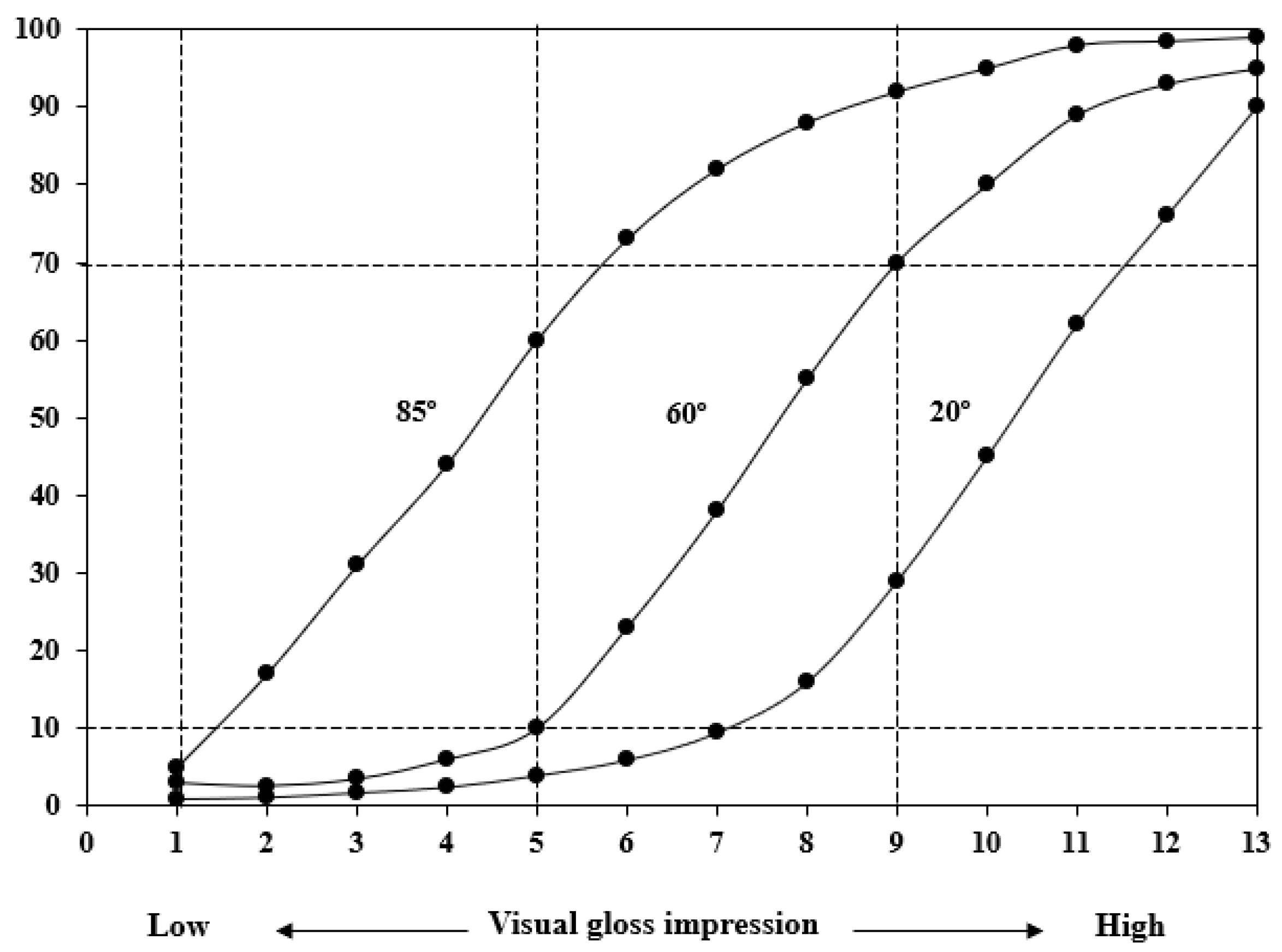


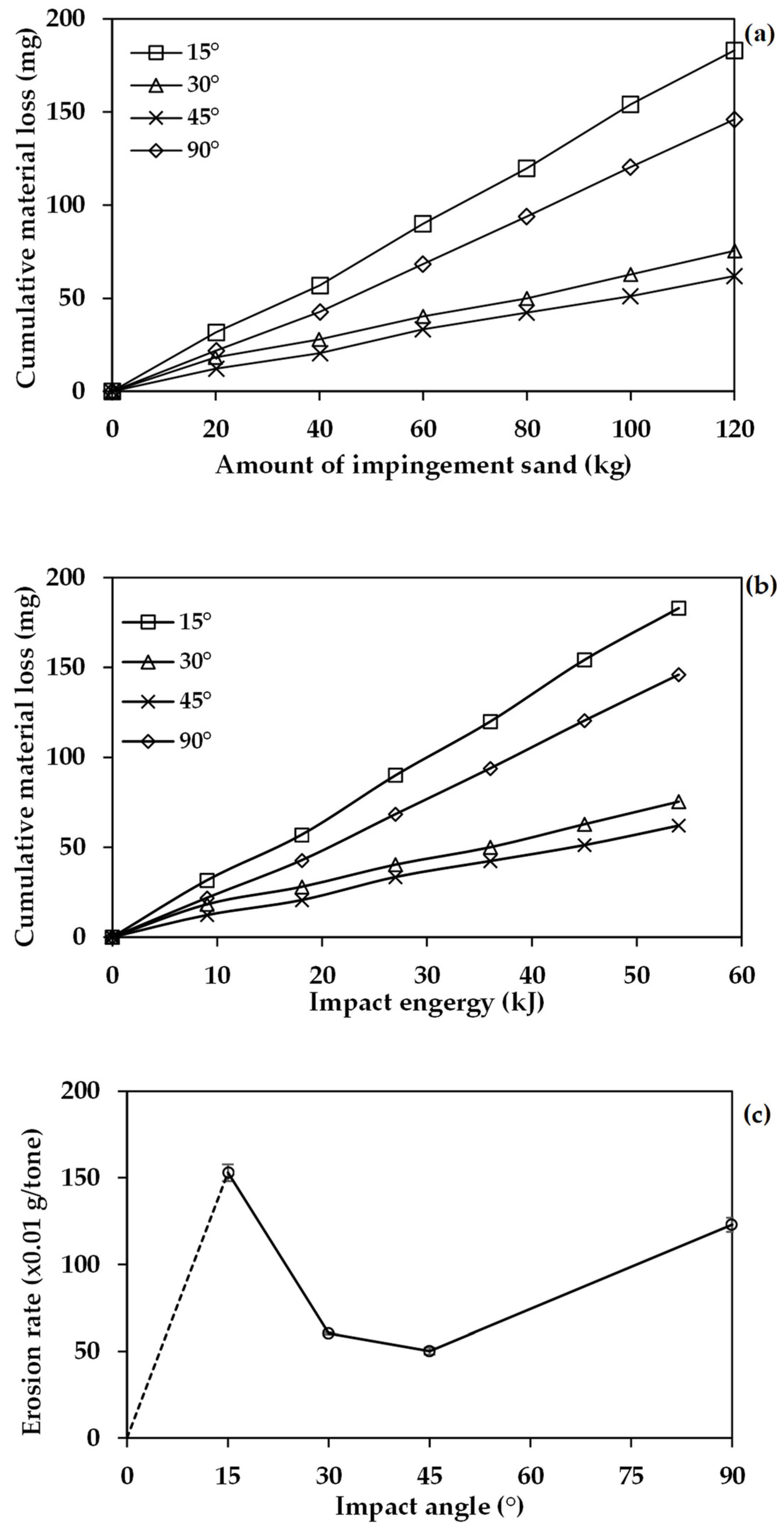

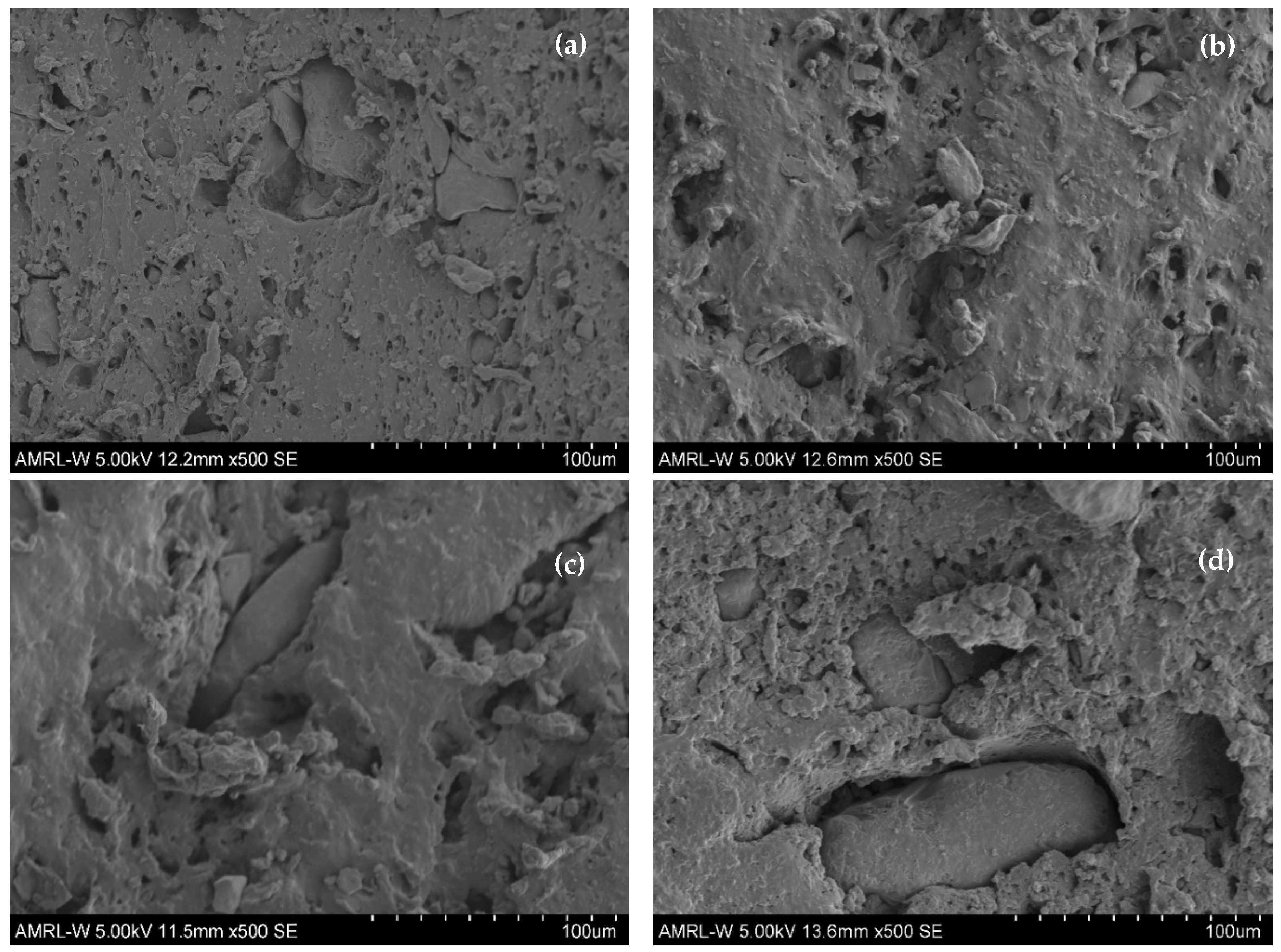
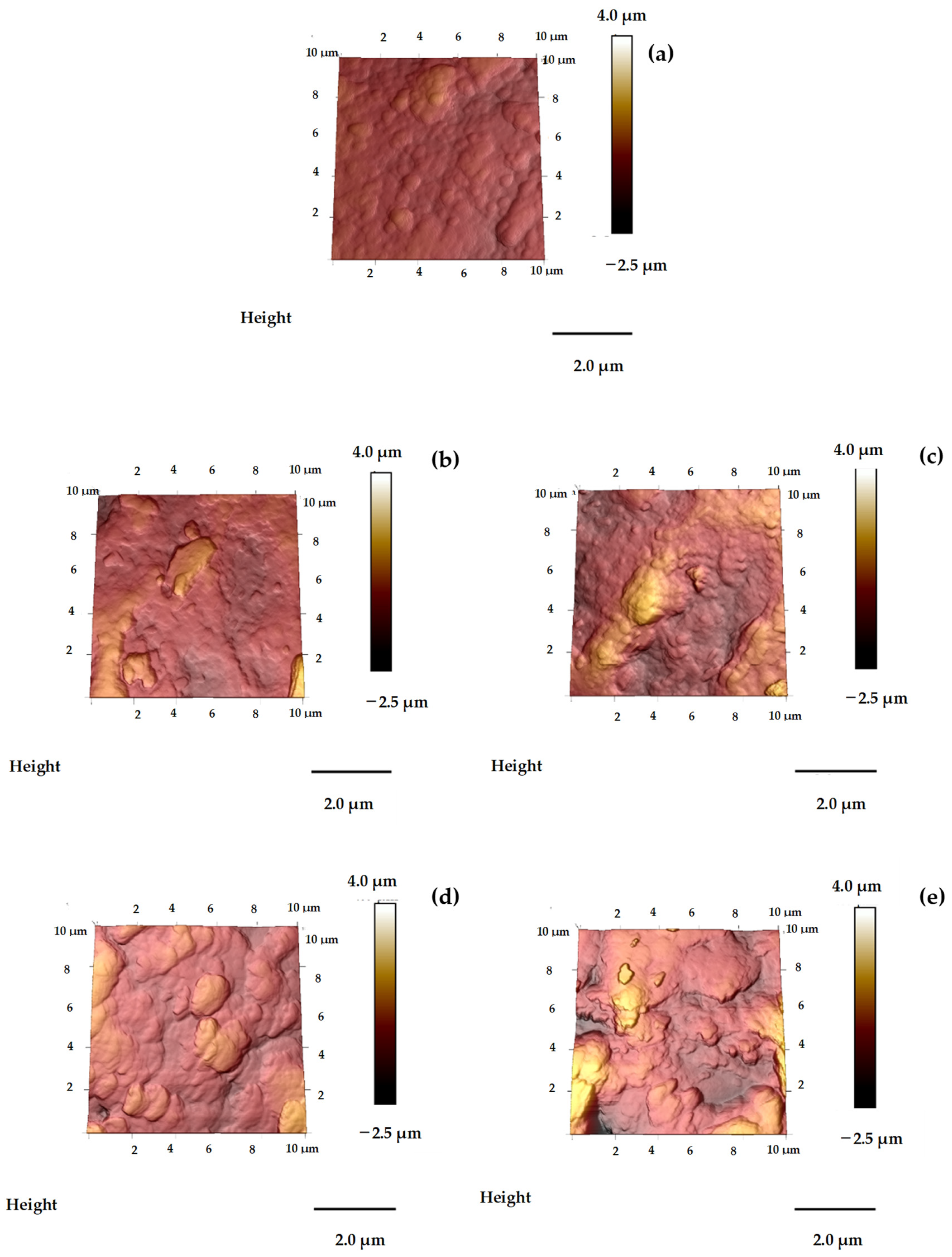
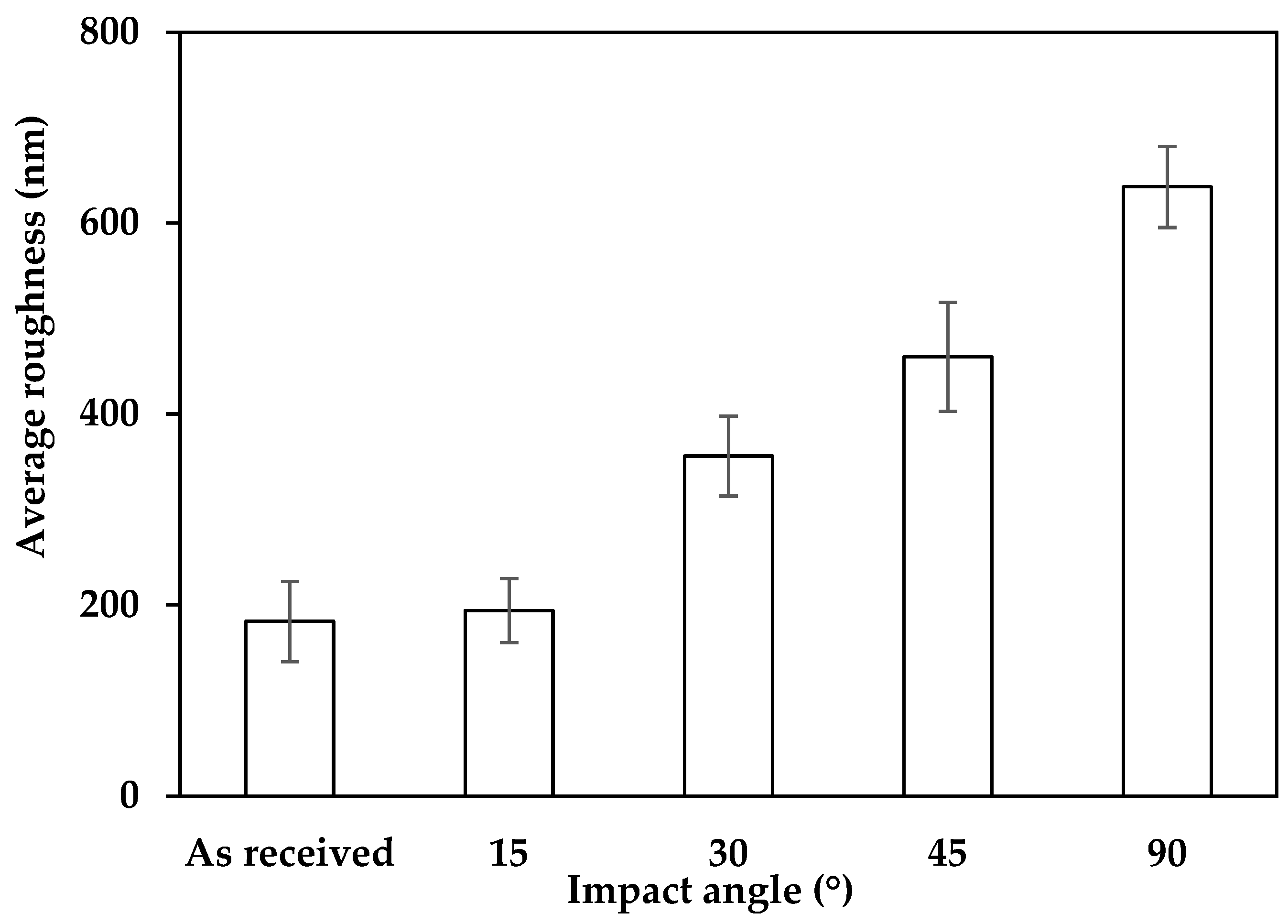
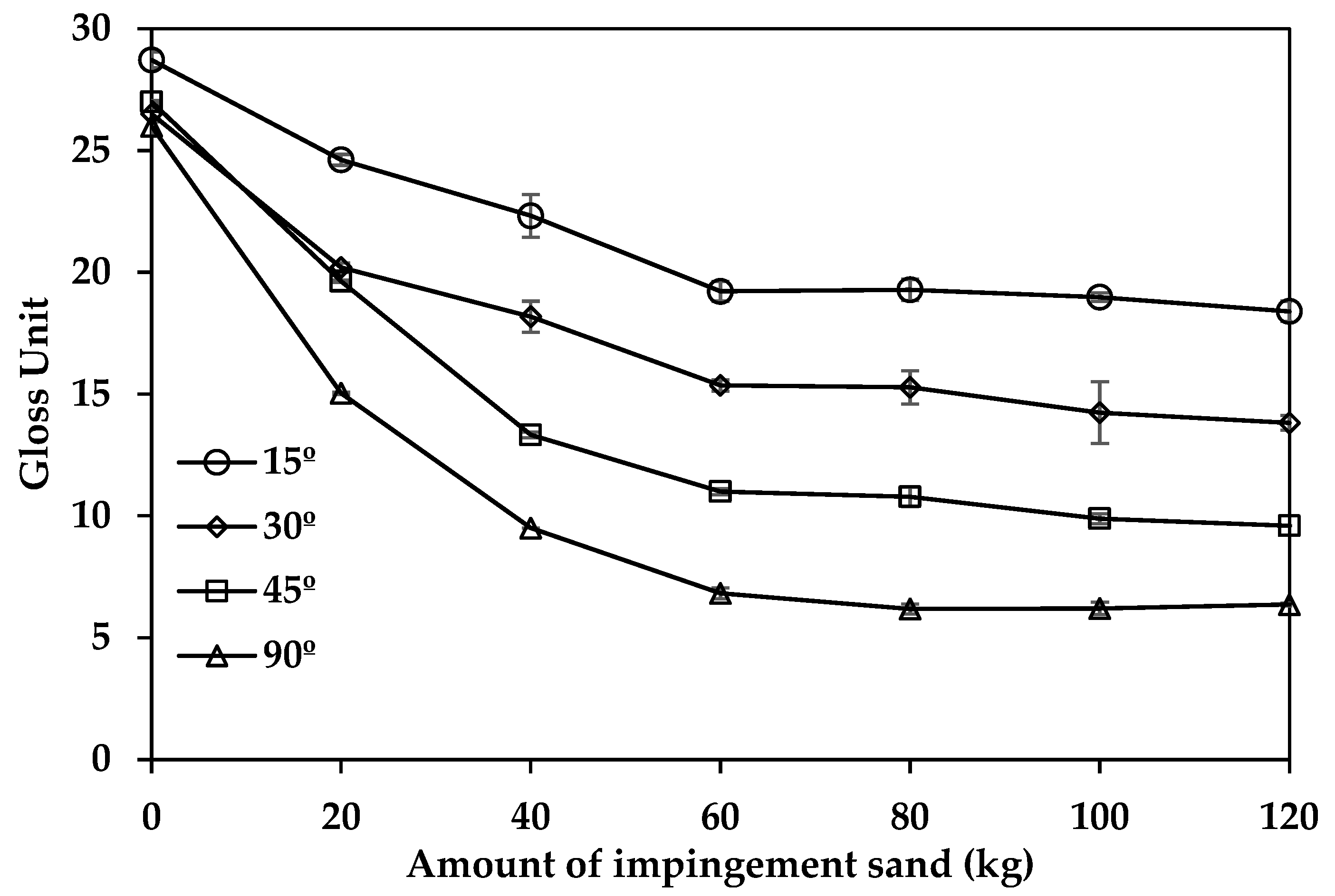
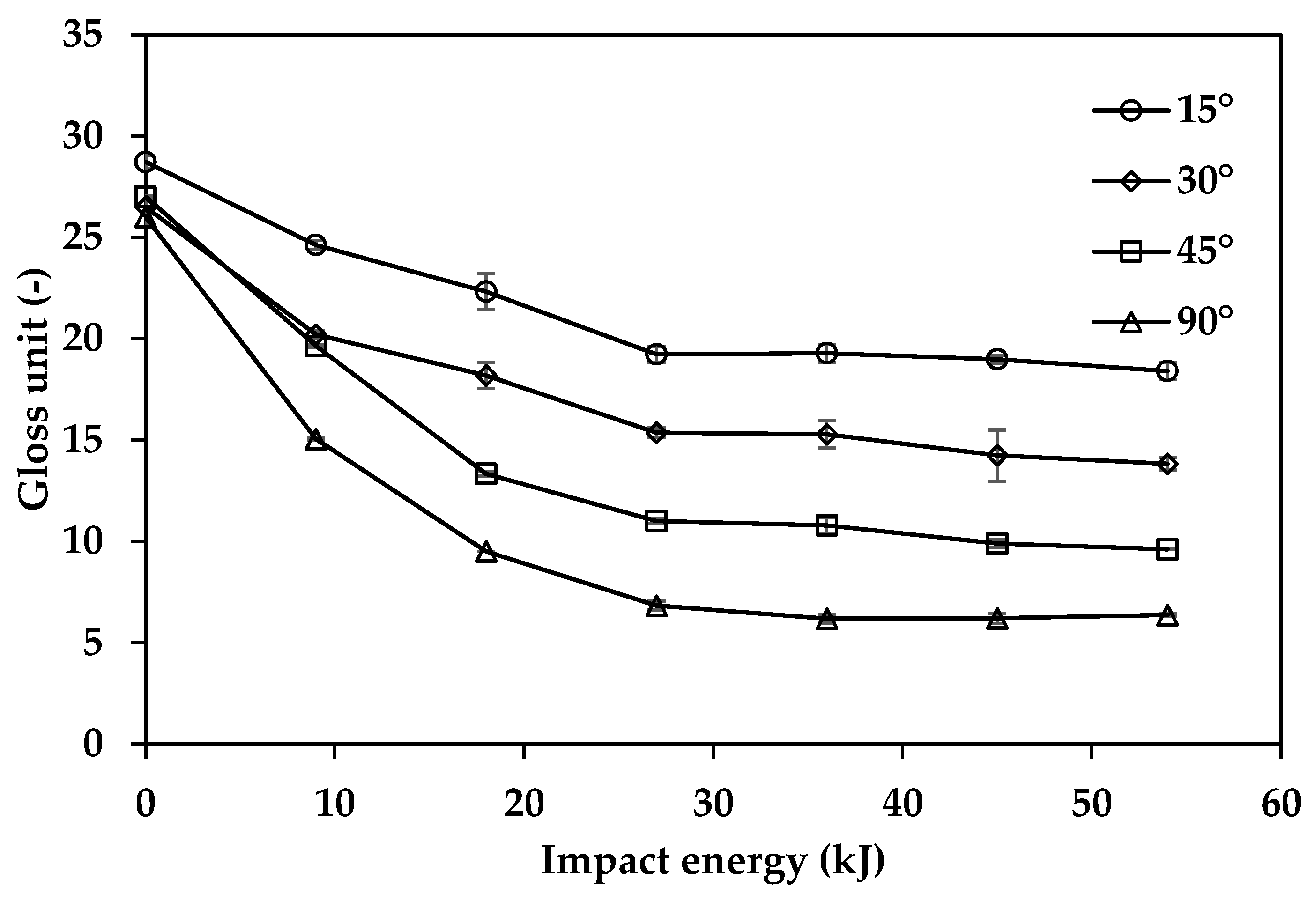

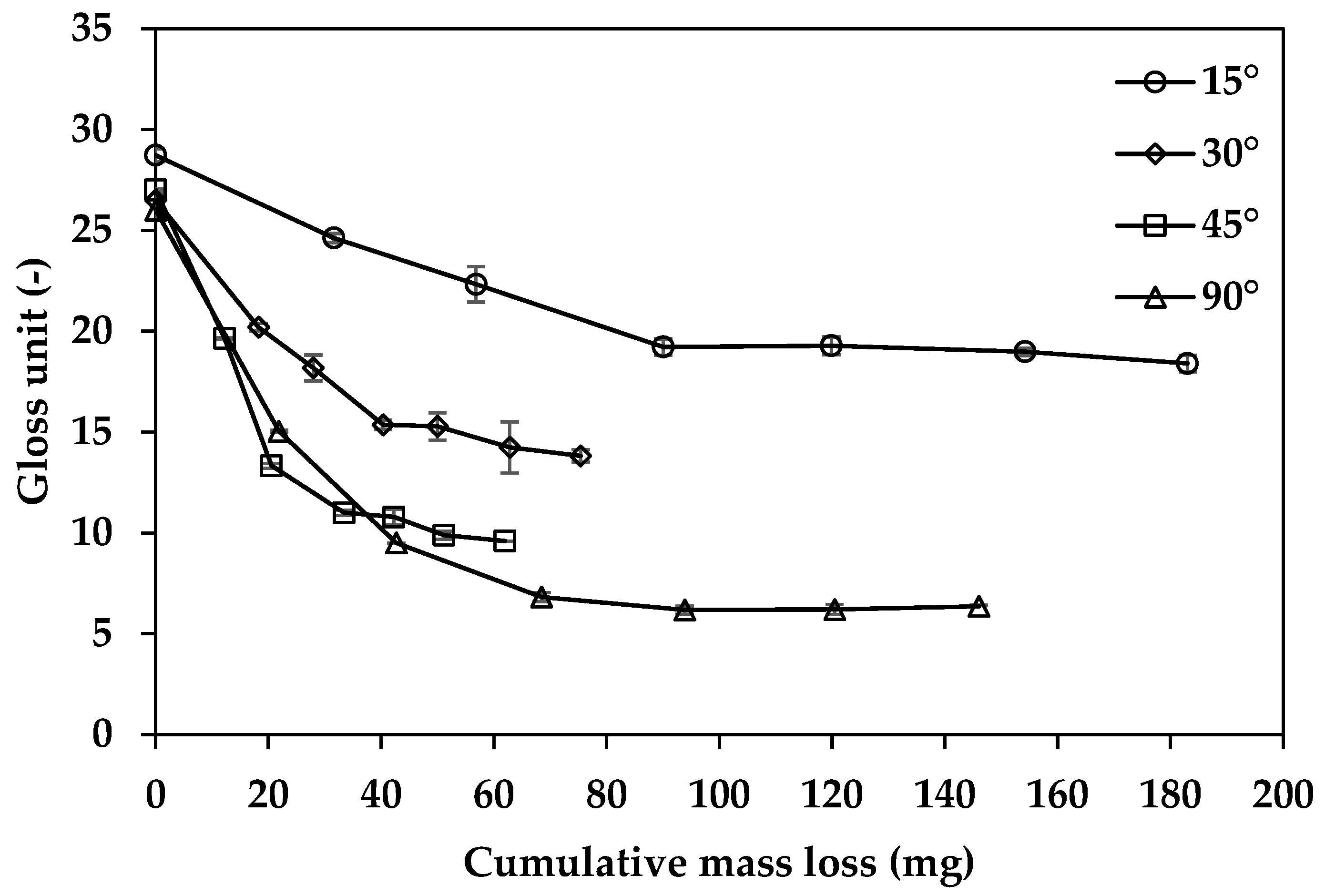
| 60° Gloss Values | Gloss Area | To Be Measured with |
|---|---|---|
| 10 to 70 GU | Medium-gloss | 60° |
| >70 GU | High gloss | 20° |
| <10 GU | Matte Gloss | 85° |
| Properties | Values |
|---|---|
| Tensile strength (MPa) | 5.0 ± 1.5 |
| Stress at 300% strain (MPa) | 5.9 ± 0.1 |
| Elongation at break (%) | 300 ± 23 |
| Hardness (IRHD) | 60.0 ± 1.7 |
| Hysteresis loss (kJ/m) | 985.7 ± 0.3 |
| Tear strength (N/mm) | 20.0 ± 1.2 |
| Specific gravity (-) | 1.4 ± 0.002 |
| Rebound resilience (%) | 27.3 ± 1.5 |
| Abrasion loss (mm3) | 506.9 ± 9.5 |
| Compression set (%) | 35.0 ± 0.7 |
| Wet abrasion resistance index (%) | 623.2 ± 5.6 |
| Water absorption (×100%) | 101.3 ± 1 |
| Average roughness (nm) | 183 ± 42 |
| Parameters | Details |
|---|---|
| Fluid medium | Fresh tap water |
| Slurry temperature (°C) | 20 ± 2 |
| Slurry velocity (m/s) | 30 |
| Sand content (wt%) | 5 |
| Sand amount/cycle (kg) | 20 |
| Impact angle (°) | Varying among 15, 30, 45, and 90 |
| Particle type | Sand |
| Sand size (µm) | 392 ± 20 |
| Stand-off distance (mm) | 30 |
| Mass of sand used (kg) | Varying on the steady-state material loss of the CR samples |
| Average Roughness (nm) | As received | Eroded CR at an Impact Angle (°) | |||
| 15 | 30 | 45 | 90 | ||
| 183 ± 42 | 194 ± 33 | 356 ± 42 | 460 ± 57 | 637 ± 42 | |
| Change (%) | - | 6 | 95 | 151 | 250 |
Disclaimer/Publisher’s Note: The statements, opinions and data contained in all publications are solely those of the individual author(s) and contributor(s) and not of MDPI and/or the editor(s). MDPI and/or the editor(s) disclaim responsibility for any injury to people or property resulting from any ideas, methods, instructions or products referred to in the content. |
© 2024 by the authors. Licensee MDPI, Basel, Switzerland. This article is an open access article distributed under the terms and conditions of the Creative Commons Attribution (CC BY) license (https://creativecommons.org/licenses/by/4.0/).
Share and Cite
Chailad, W.; Yang, L. Evaluation of Slurry-Eroded Rubber Surface Using Gloss Measurement. Coatings 2024, 14, 915. https://doi.org/10.3390/coatings14070915
Chailad W, Yang L. Evaluation of Slurry-Eroded Rubber Surface Using Gloss Measurement. Coatings. 2024; 14(7):915. https://doi.org/10.3390/coatings14070915
Chicago/Turabian StyleChailad, Wichain, and Liu Yang. 2024. "Evaluation of Slurry-Eroded Rubber Surface Using Gloss Measurement" Coatings 14, no. 7: 915. https://doi.org/10.3390/coatings14070915
APA StyleChailad, W., & Yang, L. (2024). Evaluation of Slurry-Eroded Rubber Surface Using Gloss Measurement. Coatings, 14(7), 915. https://doi.org/10.3390/coatings14070915






